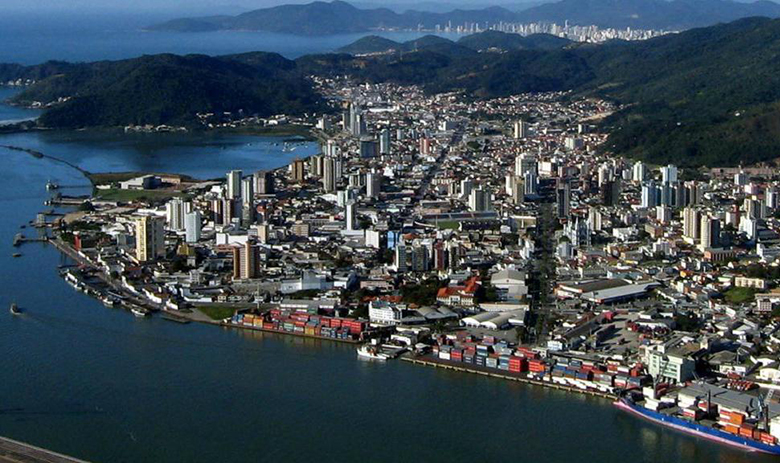The Port of Itajaí is a Brazilian port complex located in the city of Itajai, state of Santa Catarina. It is the main port of the region, the second largest in the country in container handling, acting as a port of export, draining almost all state production. The main exported products are wood, ceramic floors, machinery, sugar, paper and tobacco, and the main products imported are wheat, chemicals, engines, textiles, paper and ceramic floors.
Historical Facts
The works of the port were effectively started in 1938 with the construction of the first stretch of pier, reinforced concrete structure with 233 meters long, paved courtyards cobblestones and the first warehouse. The completion of the pier, with over 570 meters, was made in 1950, totaling 803 meters. The work was divided into two stages and lasted until mid-1956, which also began the construction of the first cold store of the Port of Itajaí.
In 1977 it was erected the administrative building of the Port and the third warehouse. In the 1980s, there was a need due to the deterioration of various parts of the wharf structure, and Portobrás, given the election of the Port Management, promoted the reform and complete recovery of the wharf.
to which the Port of Itajaí was subordinate - - Well before that, in 1934, the National Department of Ports and Navigation was created, which in 1943 received the designation National Department of Ports, Rivers and Channels, transformed into local authority in 1963 and Company of Brazil SA Ports (Portobrás) in 1975. The Port of Itajaí port was considered organized in 1966 by Decree 58,780 / 66, which also created the Administrative Board of the Port of Itajaí (Japi), responsible for the management and operation of port activities. The reason for organizing the port was its commercial and industrial importance in the Itajaí Valley and the need to integrate it into the national port system.
Port operations were leveraged by timber loads, brought from the West, Midwest and Highland regions of Santa Catarina and exported by Itajaí. But in the late 1960s, the rate of extraction of timber began to show decline, reversing the long trend of growth since the beginning of the century.
After sharp fall in timber exports, the Port of Itajaí had to adapt to the new pattern of growth of the states economy. In the early 1970s, the great Santa Catarina industry was preparing to conquer and expand its share in the foreign market. Nationally, the country was gearing in a coordinated rapid economic growth and guided by the state through planning.
From there the Port of Itajaí started to diversify its operations. Began operating loads of sugar, frozen goods and, soon after, the containers, which are now the flagship of the drive. In the same period in which the movement of containerized cargo intensified was extinguished Portobrás and the port administration was linked to the Dock Company of São Paulo (CODESP) in 1990.
The extinction of Portobrás generated a new crisis in Brazilian ports, then transferred to the command of the National Department of Ports and Waterways (DNPH), which had no defined resources and assignments. In Santa Catarina, and Itajaí, the Port of Laguna was also managed by Portobrás. The temporary and stopgap solution for both came in December 1990 with the transfer of management to CODESP.
To solve the problems and ensure the growth of the Port of Itajaí, society sparked a struggle for decentralization of administrative management, which resulted in the delegation of the Port of Itajaí to the municipality for a period of 25 years, renewable for another 25. From there the city took over the management of the port and, according to the legislation in force, it was promoted the lease container Terminal (Tecon) the special purpose company container Terminal of the Vale do Itajaí (Teconvi) today APM Terminals Itajai. This enabled the port received investments in equipment and modernization.
In addition to the administrative dilemmas, the port faced two major crises caused by the partial destruction of its structure by two major floods, one in 1983 and another in 2008.
In July 1983, the Itajaí Valley was hit by one of its biggest floods due to abnormal rainfall in the headwaters. This caused the waters of the Itajaí-Açu river, towards its mouth, came to descomunalmente increase its flow and, as a result of this, half of the Port of Itajaí pier was destroyed by the river current.
That year, the pier was rebuilt by Cobrasil. The other half of the dock was not achieved, but its structure had the same characteristic that it has collapsed, but a river whim did resist for 25 years and 6 months, until the end of November 2008, when the city of Itajaí and all the Valley region were punished with heavy rains that swamped the levels of Itajaí-Açu river and Itajaí-Mirim, causing a great flood that eventually toppled much of the Port of Itajaí pier.
Immediately the Federal Government issued a provisional measure that secured federal funds for the reconstruction of the cities affected in Santa Catarina and, consequently, for the reconstruction of the Port of Itajaí. The reconstruction works were completed in November 2010.
Details
Berths:7
Source: Official website of the Port of Itajaí.



